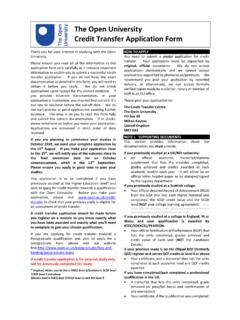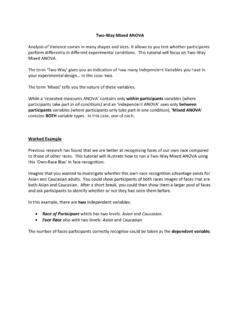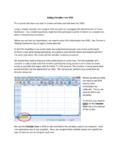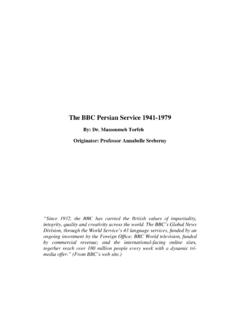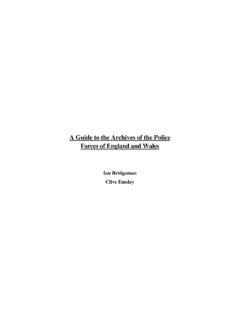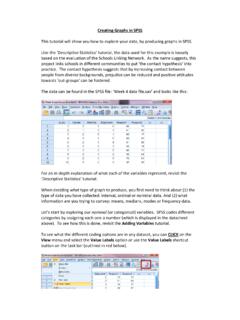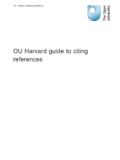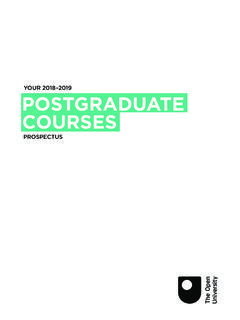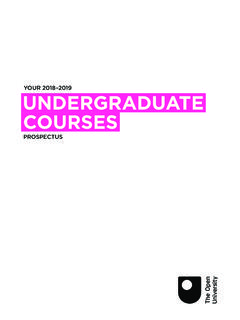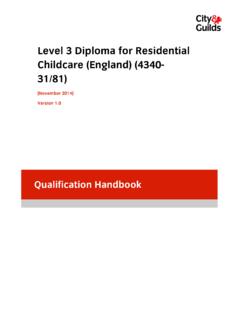Transcription of OU Harvard guide to citing references - Open University
1 LIL Library Learning ObjectsOU Harvard guide to citingreferencesContents1 Principles of in-text citations and The general structure of a reference22 In-text citations43 Reference list74 Secondary referencing85 Books, book chapters and Book Translated Modern Sacred Ancient Ebooks Ebooks on readers136 Journal and newspaper Printed journal Ejournal Printed newspaper Online newspaper articles187 OU module Module Copublished module Online module Module Module audiovisual Figures, diagrams and Secondary referencing in module citing materials from another Page Lectures, seminars and Student-generated content318 Audiovisual TV Radio Audio YouTube iTunes or other downloads389 Works of art and visual Works of Online Exhibition Plays and live performances4210 Online/electronic Personal or organisational Online Podcasts4711 Conference papers4912 Reports5013 Computer Mobile application5114 Personal Forum Telephone Personal Unpublished Second Life5515 Theses5716 Legal and legislative material5817 Patents6118 Standards6219 Maps6320 Health and Social Care641 IntroductionThis guide provides practical advice and examples to help you createreferences for information sources using theopen University (OU)Harvardstyle.
2 Some OU modules may use other referencing the details for your module before using this : this guide was revised inOctober has been slightly amended, but it should not differsignificantly from earlier versions. If your module materials askyou to reference OU module materials in a different way, pleasefollow your module s guidance. If you are unsure, contact you are unable tofind the reference type you need in this guide , youare advised tofind something similar and base your reference on thatexample. The main aim is to record the key information about yoursource to enable someone else to locate it. See theLibrary FAQ( Whatif I cannotfind the reference type I need in the OU Harvard guide tociting references ? ) for more Principles of in-text citations andreferencesWhen producing an academic assignment you are required to acknowledgethe work of others by citing references in the text and creating a list ofreferences or bibliography at the end.
3 There are two steps involved:Step 1: In-text citationsIn-text citations enable you to indicate in your work where you haveused ideas or material from other sources. Here are some examplesusing the OU Harvard style. If, for example, your source is a bookwritten by Brown and published in 1999, your in-text references wouldfollow one of these three formats:.Further work (Brown, 1999) supports this work by Brown (1999) supports this claim. This theory is supported by recent work (Brown, 1999, p. 25).For further guidance see In-text citations (Section 2) of this IntroductionStep 2: List full references at the end of your workEverything you have cited in the text of your work, for example journalarticles, web pages, podcasts, etc., should be listed in alphabeticalorder at the end.
4 This is the reference list. Each reference shouldinclude everything you need to identify the item. You need to identifythe source type ( book, journal article) and use the correctreferencing format from this guide to create the reference. If you includeitems that are not specifically cited but are relevant to the text or ofpotential interest to the reader, then that is a further guidance see Reference list (Section 3 of this guide ).Op. cit. and terms (from the Latinopere citato, in the work already cited andibidem, in the same place ) are not used in the OU Harvard The general structure of a referenceAs mentioned in Section , the main aim in providing accurate andconsistent referencing (apart from meeting academic conventions) is toenable your readers to look up the exact sources that you have cited in yourpiece of work.
5 This means that you need to give accurate information aboutthe type of item, the name or title of the item, who produced it, the date itwas produced and where you found it. All reference examples in this guideare based on a combination of some or all of these elements, depending onthe type of item. Knowing this should help you to break down a referenceinto its component parts and therefore to create references for any sourcesyou might use that aren t covered in this speaking, the key pieces of information for a reference in OUHarvard style tend to be:Author, A. A. and Other-Author, B. B. (Date) Title of item ,Title ofOverall Work[Item type/information], Publisher information/location fromwhich is usually the names of the person or people who created the specificitem you are Information literacy2 DateThis is the year, and sometimes the month and day, when the cited item waspublished or made available.
6 If no date is available, use If a work is tobe published in the near future, use forthcoming .Title/name of itemThis is the title of the specific item you have of overall workThis is the title of any overall work inwhich the item you cited appeared,for example an edited book from which you used a chapter or the type/informationThis is information about the type of item you ve cited, for example anebook, a Twitter post or a DVD. It could also be where information aboutthe nature of the item is placed, for example that this is a special issue orspecial section of a informationThis is the item publisher s location and from which accessedThis is usually a URL or web address from which the item can be elements are the basic parts from which a reference in Harvard styleis formed.
7 There are various modifications to this, depending on the type ofitem. If you can tfind an example reference in this guide for the precisetype of item you have cited, you shouldfind the most similar example andbase your reference on that, bearing in mind the elements outlined Introduction2 In-text citationsIn the Harvard system, references in the text (in-text citations) are referredto by theauthor snameandyear of publication, for example:It is stated (Bloggs, 2007) or Bloggs (2007) you are directly quoting material ( using the exact form of words usedin the original and putting the text in quote marks), you will also need toinclude thepage number(s) of the quoted materialin your in-text citation,for example:Bloggs talks about the importance of preparation for interviews (2007,p.)
8 57).This is also the case for where you use quoted material from all the types oftext referred to in the rest of this guide , unless page numbers are quotes should be displayed in a separate paragraph, for example:Bloggs (2007, p. 348) is more critical:I don t agree with this at all, the argument is poorly made and doesnot hold up to any scrutiny. One begins to wonder if we shall eversee any sense from this organisation on this subject at any time inthe next one hundred you do not name the source in the lead-in to the quote, then it must begiven after it:Other commentators are more critical:I don t agree with this at all, the argument is poorly made and doesnot hold up to any scrutiny. One begins to wonder if we shall everX443 Information literacy4see any sense from this organisation on this subject at any time inthe next one hundred years.
9 (Bloggs, 2007, p. 348)Authors with more than one publicationIn the reference list or bibliography, items are listed onlyonce inalphabetical order. In some cases you may refer to more than onepublication by an author for a specific year. To help identify these differentitems for your in-text citation and reference list, you should add a letter ofthe alphabet to the year of publication, for example:(Thomson, 2004a), (Thomson, 2004b) and (Thomson, 2004c) where a,b and c refer to the order in which they are cited in your authorsIf a publication hasthreeormoreauthors the in-text citation should listonly thefirst author followed by et al. ( and others ). For example:(Jones et al., 2006)but in the reference list or bibliography you would list each author in full asfollows:Jones, R.
10 , Andrew, T. and MacColl, J. (2006)The InstitutionalRepository, Oxford, Chandos multiple sourcesWhere you have several in-text citations together, you should order them inreverse chronological order, beginning with the most recently publishedsource, and separate each source with a semicolon (;). If more than onework is published in the same year, order these texts alphabetically byauthor.(Frobisher, 2012; Barnes et al., 2009; Huy, 2009; Monk andBosco, 2001)52 In-text citationsOp. cit. and terms (from the Latinopere citato, in the work already cited andibidem, in the same place ) are not used in the OU Harvard Information literacy63 Reference listReferences in thereference listorbibliographygive, in alphabetical orderby author surname, full details of all the sources you have used in the a corporate author s name starts with The ,usethefirst main wordof the title when alphabetising, The open University is listed under O.
